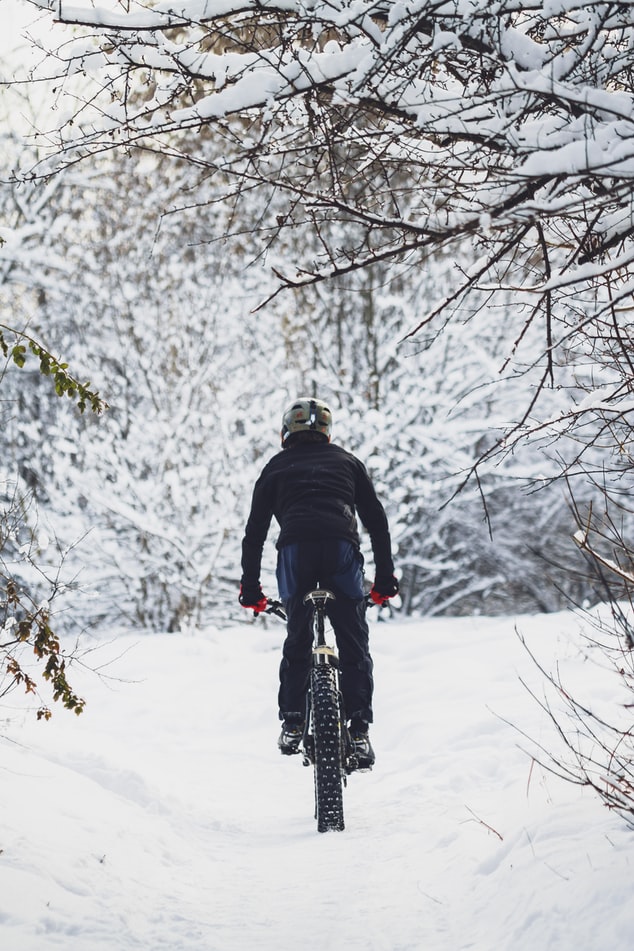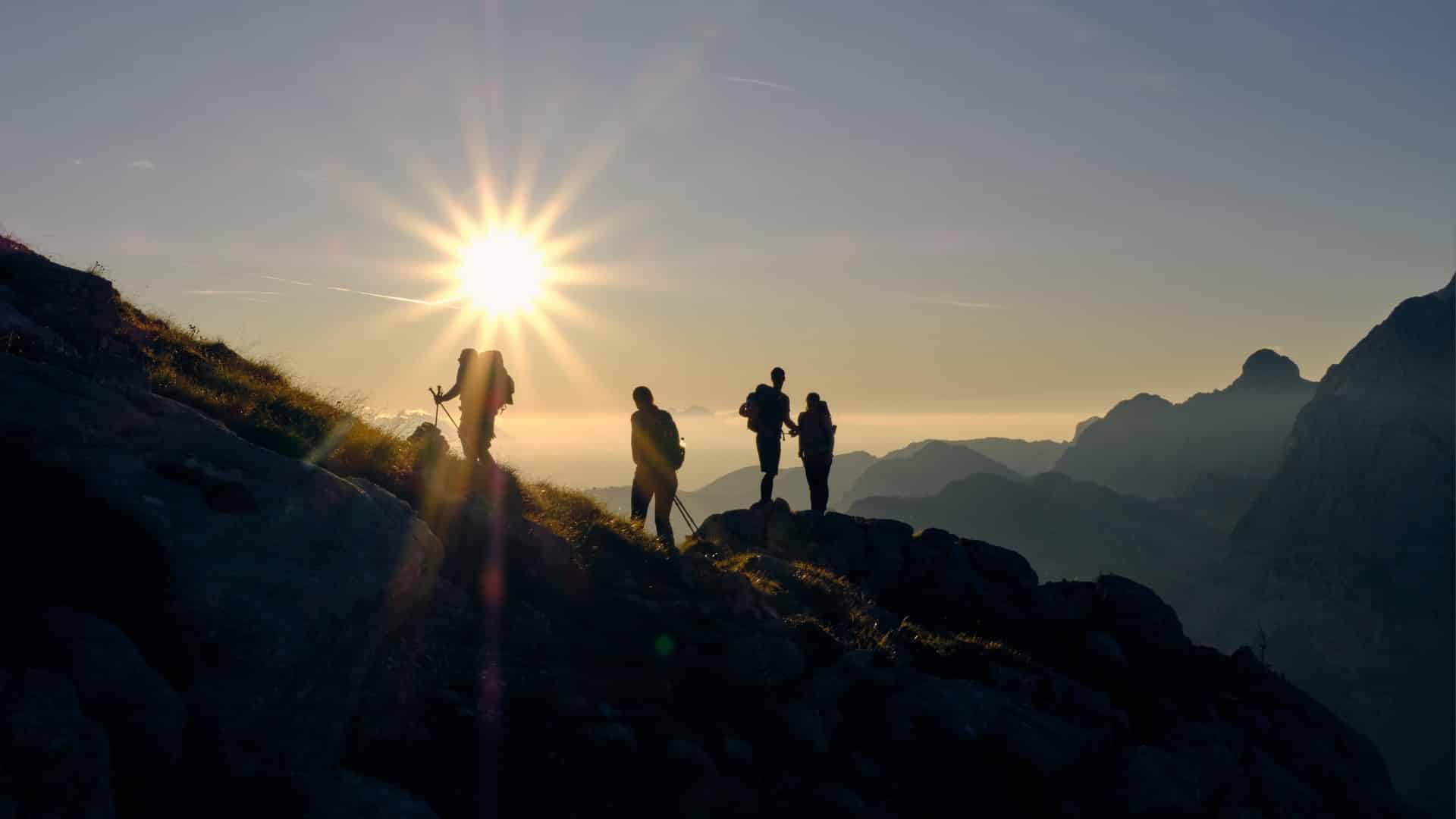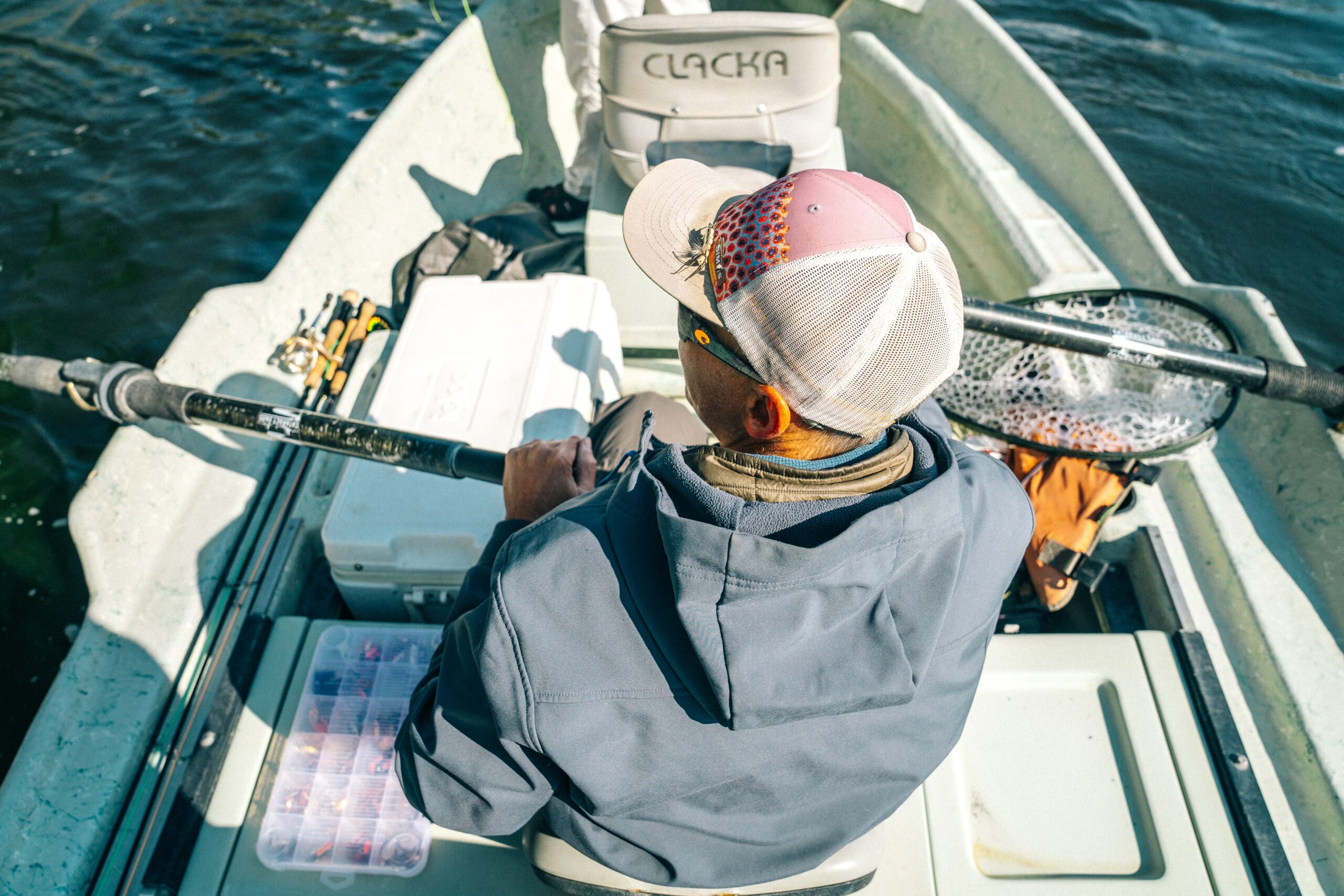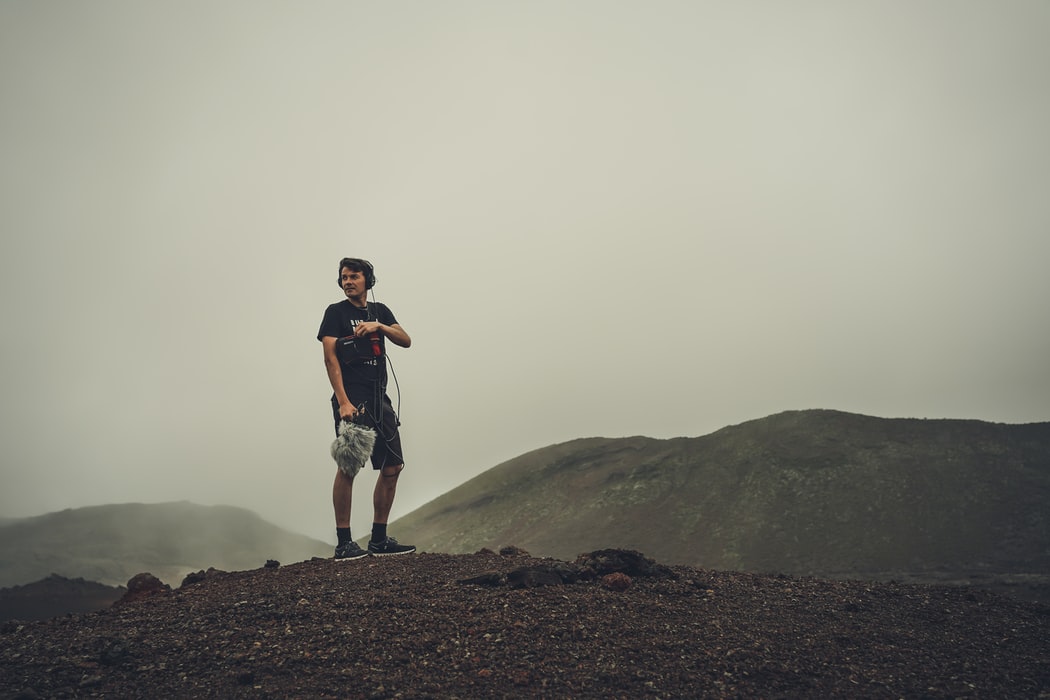It’s cold. It’s dark. There’s a blanket of frost on the ground and the bike’s collecting dust. Now’s your moment to seize adventure.
Winter bike riding does not have to break the bank nor does it have to be miserable. Winter is perfect for new activities. To get a little bit adventurous.
Here’s how you can “opt outside” and not freeze:
Benefits of biking in the winter
The first thing you want to do when the thermometer reads 32°F is hop on a bike and ride through the snow and ice, right?
Why would you want to layer up and take your steed out in freezing temperatures? For the adventure.
There are fewer people on the trails.
Riding your bike in the winter grants you peace outside and we all love a little peace and quiet. A lot of us don’t get enough of it. More people escape the cold than brave it, so you’ll likely have the trails to yourself.
It puts you in a better mood.
It’s hard enough to get out of bed in the dead of the winter. It’s a whole other story when the sun’s still below the horizon. As you layer clothes before jumping on the bike, when you can still see your breath, that’s the moment. The moment right before you take off. The possibilities that await.
Movement releases those happy feelings we get from exercising.
Whether you’re gearing up to commute or for a mid-day adventure, riding your bike puts you in a better mood. Remember how you felt as a kid? As they say, “There’s no bad day on a bike.”
You’ll get a dose of Vitamin D
During the winter, we end up Vitamin D deficient because we’re spending so much time indoors. Vitamin D is important. It keeps your bones, body, and immune system healthy. One way to combat lower Vitamin D levels during the winter is jumping on your bike and riding outside. Natural sunlight helps boost your mood and keep you healthy. Remember to protect your skin with sunscreen when you head outside. A sunburn won’t help your skin.
Commuting without the cons
If you ride your bike as a form of transportation, you get the benefits of commuting without the cons. You save on gas and you help keep the planet green without contributing to pollution. You also avoid overcrowded public transportation and traffic jams. When you arrive at the office, think about how relaxed and awake you’ll be without the typical frustrations.
Discover new trails
Some of your typical trails during the winter may be closed which means you get to discover new ones. There are a lot of apps nowadays, like MapMyRide and Ride With GPS, that map routes for you. You need to be a bit of an adventurer and if you’re reading this blog, you already are. Discovering new trails changes up the typical routine. You’re not going to get bored riding the same route over and over again.
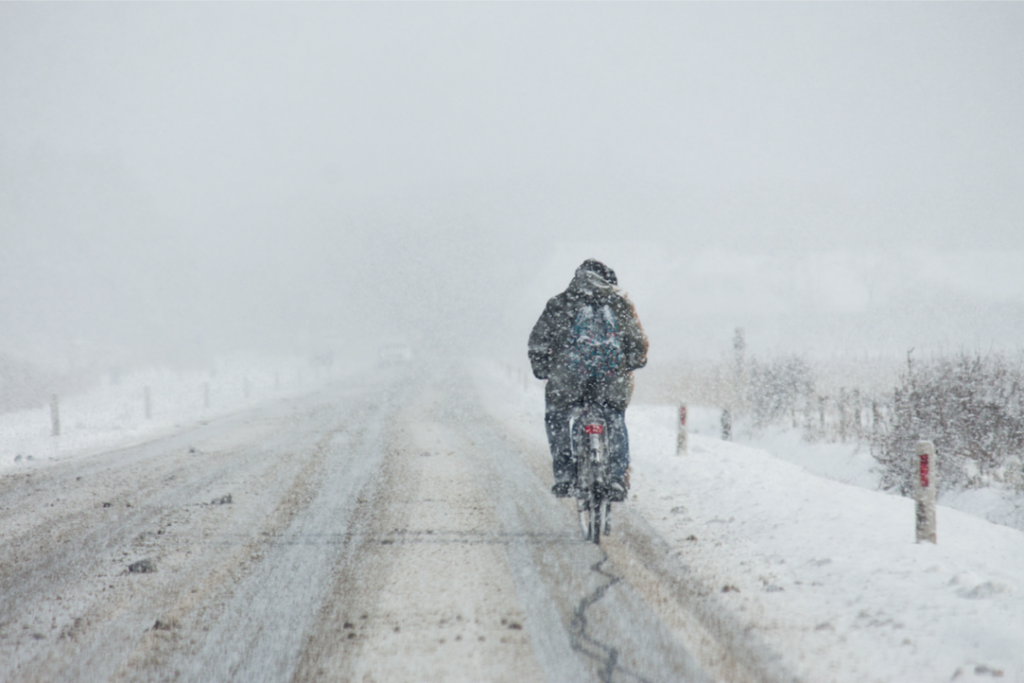
Ease into it
Riding in the winter doesn’t have to be an all-or-nothing endeavor. You don’t have to buy a new bike or upgrade your current gear. You can ease yourself into it before committing 100%.
Start in the Fall
As the weather begins to cool, learn what layers you need to ride comfortably. Pro tip: when you step outside to jump on the bike, you want to be a little cool.
Not freezing.
Cool enough that once you start riding (and as your body produces energy), you’ll warm up.
This prevents overheating. If you’re warm before you start riding your bike, you’re going to sweat. Sweat will cool you down once it dries from your skin. If you’re not wearing something that wicks it away, you’re going to be colder than if you would have started a tad chilly.
As Fall turns to Winter, you’ll be used to riding in cooler temps and able to adjust again. It won’t be as abrupt as going from a summer rider to a full-fledged winter warrior. There’s nothing wrong with getting used to a mild change first.
Pick short routes when you start
When it’s your first-time winter riding, the last thing you want to do is get 40 miles away from home and realize you’re too cold, run out of nutrition and supplies, are completely miserable, and have to call a family member or friend to come to the rescue.
Pick a short route at first.
If you realize the water froze in your bottle, you’re not too far from home to change bottles. Or, if the weather turns, you’re close enough to endure a few miles instead of hours.
Completing short out-and-backs or loops will give you a bigger sense of accomplishment. You wouldn’t go from riding 10 miles to 100 miles. A shorter route the first time you ride your bike in the winter sets you up for the second ride better. You’ll know you can handle the mileage and go further the next time.
Know your skills
Winter riding requires different skills to navigate paths. Have you ridden on ice before? Snow? How about sections of dirt? Assess your skills before charging tire-first into the wintry wonderlands.
The last thing you want is to crash and hurt yourself and your bike.
On a short route, find a section of a snowy or icy route and practice riding your bike through it. Do it a few times. Ride until you’re at a comfortable speed and successfully navigated through it. Then do it one more time for good measure.
Practicing your bike handling skills before you really need it is crucial.
Go with someone who knows what they’re doing
If all else fails, find a friend who’s been doing it for a while. They can give you pointers, help you steer through sketchy sections on the path, and may let you borrow some gear. That’s what friends are for.
Use what you’ve got
Using what you currently own is the easiest and most effective way to get started. Sure, you’re using a scarf, snowboard gloves, and waterproof hiking boots, but who cares? You’re outside, exploring, and riding your bike.
You’ll learn what you need and don’t need. This is a surefire way to keep things cheap and warm. If you enjoy it, invest in high-quality cycling-specific winter gear.

Clothing Essentials
If you’re ready to step up your clothing game here’s a list of some of the essentials to stay warm. If you have no idea how to layer up for a winter bike ride, keep reading.
These will differ depending on the day’s weather.
Colder weather requires more layers. Snowier weather needs different gear. Wet weather, again, will require something different.
Mix and match as you please and what works best for your best winter riding.
Earflap Cycling Cap
Warmth escapes from your head. Keep your head, ears, and neck warm with an earflap cycling cap. Riding on the bike is usually 10° colder. Get a cycling-specific cap to make sure it fits under your helmet as you ride. They aren’t too expensive, roughly $30-$50 but you don’t have to buy one either.
Hack it: Use a skull cap beanie instead. They’re half the price and cover your head and ears. You can also wrap a bandana around your head and ears if you already have one.
Balaclava
This isn’t a dessert. It’s a piece of material that covers your entire head, face, and neck. A different version is more of a neck gaiter that wraps around your head and pulls up to cover your mouth and nose.
These are great for cold weather riding to protect your face from the harsh elements of winter.
Hack it: You can use the scarf you wear around town or a bandana to protect your face instead.
Thermal bibs or pants
If you’re looking for something cycling-specific, buy thermal bibs or pants. Thermal bibs are built with breathable material which helps keep you warm and dry. Others have moisture-wicking properties to pull sweat away from your body to the surface of the material.
This gear is perfect for longer routes on the saddle so you’ll stay comfortable the whole ride.
Hack it: If you’re sticking to shorter routes, layer up with some snow pants. It won’t be as comfortable as cycling-specific pants but if they can keep you warm during a day on the mountain, you’ll stay warm on the bike too.
Shoe or toe covers
Shoe or toe covers are also cycling-specific. These products wrap over your cycling shoes. It helps block the wind as you pedal. Cold and numb feet will have you turning around or phoning a friend fast. And how miserable is it to be riding your bike and your feet are too cold to turn the pedals?
Hack it: Don’t want to buy shoe or toe covers? No problem. Line aluminum foil around your feet (inside your shoe) as an added protection of warmth and as a windbreaker. It’ll be a little crunchy and uncomfortable but your feet will stay warmer.
Gloves
There are cycling-specific gloves. The reason why you’d want cycling-specific gloves is to make it easier to change gears and brake. These kinds of gloves are an investment so before you buy, DIY it and see if that works better.
Also, if you have a pair and your fingers still get chilly, wear latex gloves under them.
It’ll keep your hands warm – and if you end up having to change a tire or mess with your chain, your hands will stay clean.
Hack it: Pick up some winter gloves from Army Surplus if you don’t currently own a pair. It won’t be as easy to change gears or brake but your hands will stay warm.
Find gloves and not mittens as that can actually be dangerous.
Make sure you can brake wearing gloves before venturing outside.
Base Layer
As you start to layer your upper body, begin with a base layer.
These are great because they help regulate your body heat.
If possible, find something made of merino wool.
Merino wool is a great thermoregulator as it’ll keep you warm and dry when it’s cold and cool when it’s hot. Its moisture-wicking properties are especially important riding during the winter. You want sweat off your skin to stay warm when it’s cold.
Mid-Layer
The next layer is a mid-layer, especially for cold days. The mid-layer’s insulation help keep the warmth in without your body heat escaping. Avoid cotton as it tends to soak up sweat and treat yourself to merino wool.
Hack it: Unusual, but effective, stuff newspaper under your outer layer and over your base layer for a DIY mid-layer. Again, you’ll be crunchy but the newspaper helps insulate your body warmth and prevents it from escaping through your clothes.
Outer layer
If you’re not concerned with speed or aerodynamics, a winter coat will work as an outer layer. Work with what you’ve got before you start upgrading your cycling clothing.
Socks
Wool socks are a great friend to have for bike riding in the winter. Be sure they’re not so thick you can’t fit your foot inside your cycling shoe. If your foot is too constricted, it will make it uncomfortable during your ride.
Hack: Wrap your socks in a plastic bag before putting your feet into your shoes. This helps block the wind. If you’re prone to cold feet and you have the room, put on a sock, wrap it in the plastic bag, then put on another sock. Double the insulation.
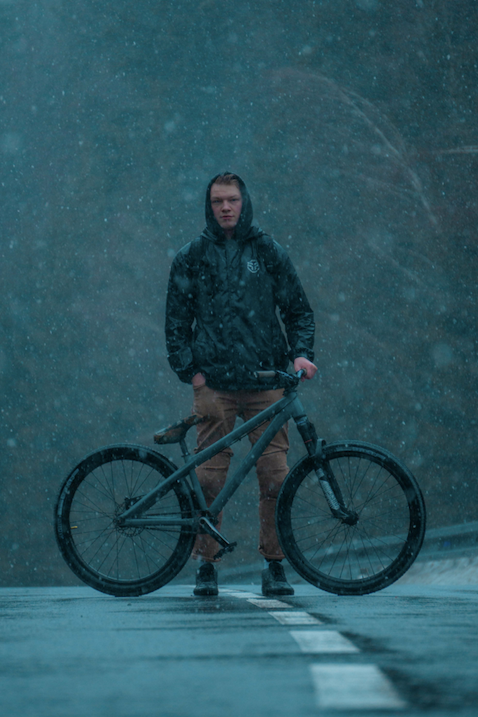
Bike Essentials
You’ve got the gear nailed down (or at least have a better idea for a starting point). Now you have to make sure your bike’s dialed. Some of these cost nothing and some have a price. Consider your goals and your safety with winter bike riding then pick and choose.
Fenders
Bike fenders prevent mud and water from spraying up your backside and at your face. As soon as the snow starts to melt there will be puddles. If you don’t mind getting dirty then skip it. For those of us who don’t like a mouthful of dirt, cheap fenders will help thwart the spray.
Lower PSI
Letting out a little air from your tires will give you a bit more grip on the road when it’s wet, icy, or snowy. How much air you let out depends on your weight, the bike’s weight, and the terrain. Dryer, harder terrain requires higher PSI. Icy, snowy, softer terrain will need lower PSI. Check your bike manufacturer’s guide or ask a friend who knows what they’re talking about.
Thermal bottles
Thermal water bottles help stop your drinks from freezing in the winter and keep them cooler in the summer.
Hack: Don’t want to buy a thermal water bottle? You can stuff a bottle in your jersey pocket under a coat to help prevent it from freezing.
Studded tires
If you’re invested in cycling, you can buy studded tires. They work the same way as car tires. You’re not going to stop as fast as you would on the pavement but they do give you more traction. You’ll have more traction on snowy or icy paths and boost your confidence.
Studded tires aren’t cheap.
If you’ve been practicing your skills around your neighborhood and have the confidence to ride, then do without.
If you’re still intimidated by riding over ice and you can afford them, buy yourself some studded tires.
Some people opt to ride a mountain bike instead of a road bike during the winter because mountain bikes are more stable on the snow and ice. If you have a mountain bike, give it a try.
Remember to clean your bike often
Winter’s harsher on your bike than Summer. This means you’ll have to clean your bike more than you normally would. And no, don’t skip it. The grime, salt, sand, and dirt gunks up the gears and chain fast. Unless you have a beater bike you’re okay trashing, clean your bike.
Lights
During Winter, the days are shorter and darker. If you’re out exploring on your bike, you’re bound to get caught in the dark.
Stay safe and get a front and rear light. There are a ton on the market. Get something in your price range and something people will see.
We all bike for different reasons, whether that’s to gain fitness, commute, or for the adventure. Riding your bike doesn’t have to stop in the Winter and it certainly doesn’t have to be miserable. If you prepare yourself with the proper gear, winter bike riding will become your next favorite activity.
Into other winter adventures? Read our article, 7 Essential Tips To Prepare For Winter Adventures.

